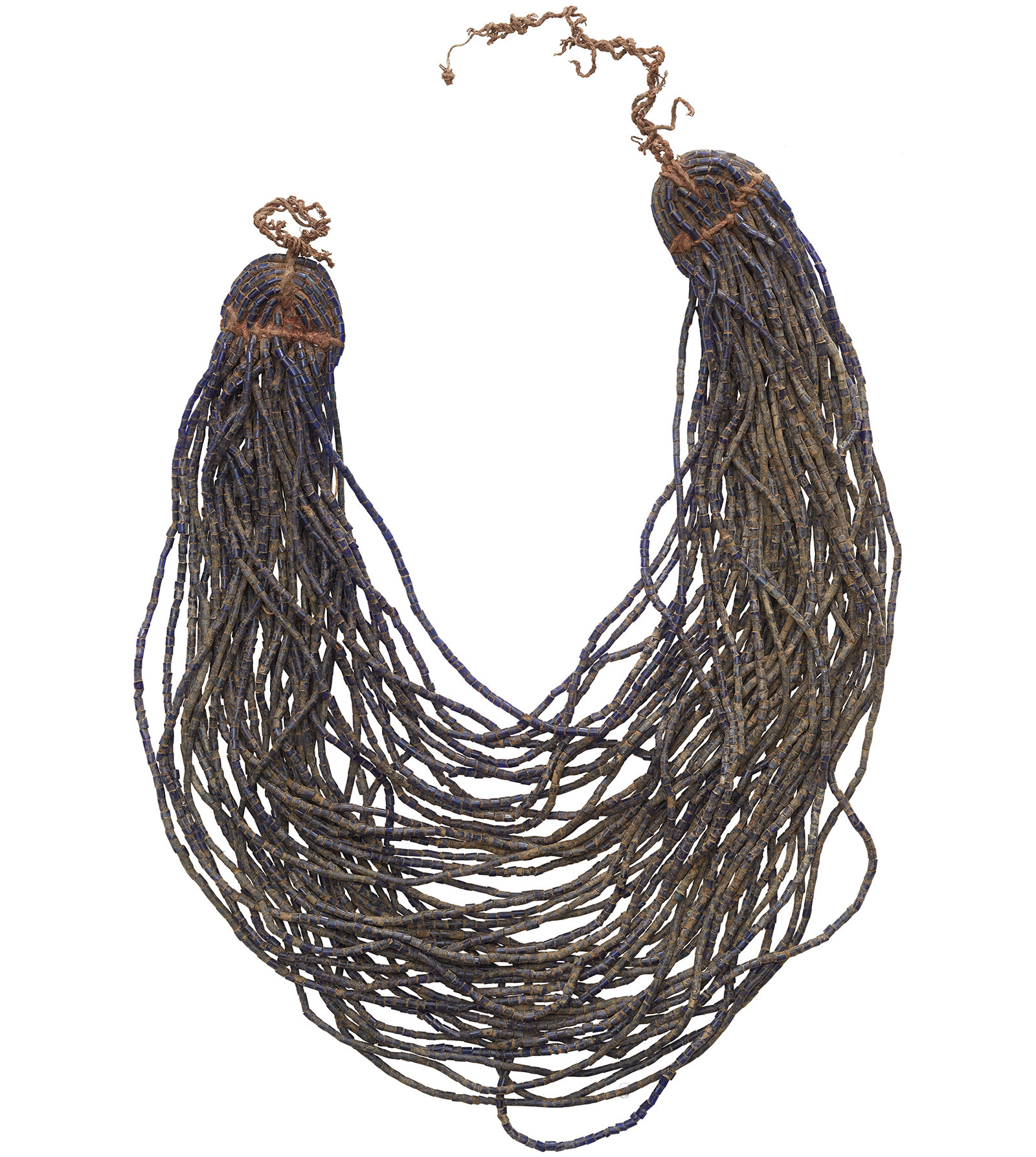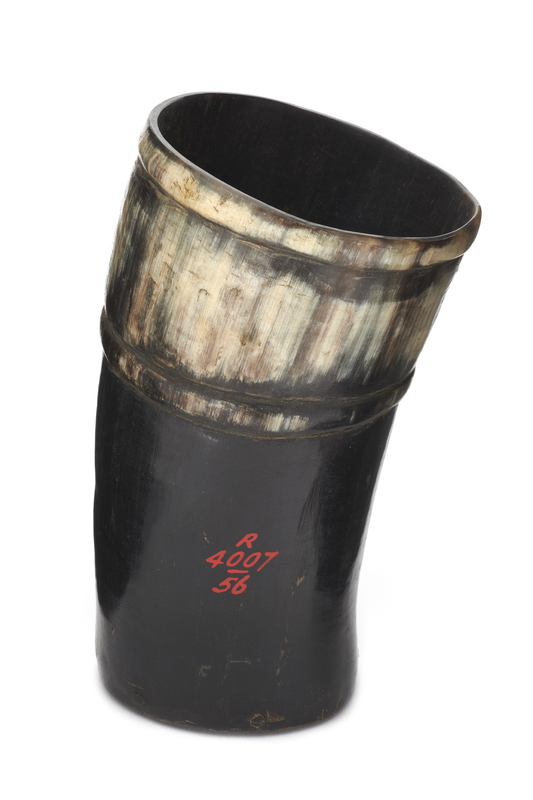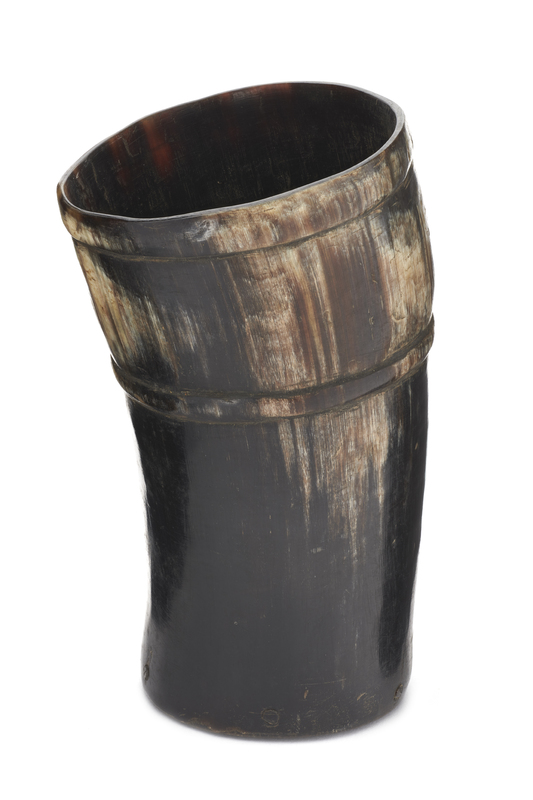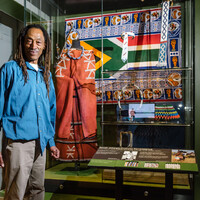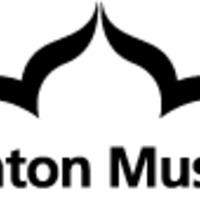Horn Vessel; Tumbler; Kopi; Bekere
Item
Title
Horn Vessel; Tumbler; Kopi; Bekere
Creator
Unrecorded
Description
Physical Description: Horn tumbler in a dark brown graduating to striped cream colour in the top half. The shape follows the natural curve of the horn, with a decorative ridge carved one third of the way from the top, and at the rim.
Contextual Description: Kopi is from Afrikaans words koppie and koppitjie (Cup and small cup) TS comments
Contextual Description: SL 37:00I don't know, if the guy is rich he can store gunpowder in there...
GK 37:38
its like beautiful leather.
SL 37:42
So they were making tumblers
WT 37:44
I think we need something like that. It's a new it's um, it's an old innovation that we don't know now.
GK 37:52
Then later,... the calabashes, the calabashes and then the kopi
SL 37:58
the Calabashes...see that period This was copying the bazungu's table one.. Yeah, this was copying the bazungu's table where the calabash was what was used before...
WT 38:15
That I do understand but this is also unique and really know where it came from
SL 38:23
It was something copied from there.
SL 41:51
This side [of the country]...the word kopi which is a cup will be more common. Then as you go south of Botswana, the word bekere would be more common among the Ba-Kgatla and other tribes Those who have had more… what you call with the Afrikaans…
SL 42:59
a tumbler or a beaker or a scooper that we use in our setswana thing was known as sego but that's like a one made out of a ke-eng. Like a gourd (ke leka go tlhalosa tiriso ya teng gone sene se bereka go kgantsa = I am trying to explain the use of it because it works to explain or describe it) cos maybe early on it was used as a cup, scoop water with it, you can drink even when you go to the to the river to get water from the [seeping?] well, like normal [??] you'd be using that sego to get that, scoop water with and collect it into your your water pot up until you fill your water pot and then you take what is known as the di-pugo some branches and you cover your thing, your water pot and then you make another kgare a coil out of cloth which you put on your head so that you can sit your water pot there.
The above notes are from a transcription by Kathleen Lawther of a discussion between Gase Kediseng, JoAnn McGregor, Nicola Stylianou, Scobie Lekhuthile and Winani Thebele which took place at the Khama III Memorial Museum on the 5th of August 2019. To listen to the full recording please follow the link below.
GK 37:38
its like beautiful leather.
SL 37:42
So they were making tumblers
WT 37:44
I think we need something like that. It's a new it's um, it's an old innovation that we don't know now.
GK 37:52
Then later,... the calabashes, the calabashes and then the kopi
SL 37:58
the Calabashes...see that period This was copying the bazungu's table one.. Yeah, this was copying the bazungu's table where the calabash was what was used before...
WT 38:15
That I do understand but this is also unique and really know where it came from
SL 38:23
It was something copied from there.
SL 41:51
This side [of the country]...the word kopi which is a cup will be more common. Then as you go south of Botswana, the word bekere would be more common among the Ba-Kgatla and other tribes Those who have had more… what you call with the Afrikaans…
SL 42:59
a tumbler or a beaker or a scooper that we use in our setswana thing was known as sego but that's like a one made out of a ke-eng. Like a gourd (ke leka go tlhalosa tiriso ya teng gone sene se bereka go kgantsa = I am trying to explain the use of it because it works to explain or describe it) cos maybe early on it was used as a cup, scoop water with it, you can drink even when you go to the to the river to get water from the [seeping?] well, like normal [??] you'd be using that sego to get that, scoop water with and collect it into your your water pot up until you fill your water pot and then you take what is known as the di-pugo some branches and you cover your thing, your water pot and then you make another kgare a coil out of cloth which you put on your head so that you can sit your water pot there.
The above notes are from a transcription by Kathleen Lawther of a discussion between Gase Kediseng, JoAnn McGregor, Nicola Stylianou, Scobie Lekhuthile and Winani Thebele which took place at the Khama III Memorial Museum on the 5th of August 2019. To listen to the full recording please follow the link below.
Publisher
Making African Connections
Date
Pre 1899
Type
PhysicalObject
Format
Whole: 115 mm x 70 mm x 60 mm
Identifier
R4007/56
Source
Collected by Reverend William Charles Willoughby, a Christian missionary, in what was then the Bechuanaland Protectorate (1885-1966). It is now the Republic of Botswana, having gained independence from Britain in 1966.
From 1889-92 Willoughby was pastor at Union Street Church, Brighton (now The Font pub). From 1893 to 1898 he worked for the London Missionary Society in Bechuanaland. He assembled this collection of objects during this period. This was a period of social and technological changes and these objects represent traditional lifestyles and skills, rather than the contemporary lives of the people Willoughby met.
Willoughby's collection was loaned to Brighton Museum in 1899 when he returned to the UK. The loan was converted into a donation in 1936, and accessioned as acquisition R4007.
Some objects were re-numbered with the WA (World Art) numbering system in the 2000s. These numbers have been reverted to the original R4007/... numbers where possible for consistency in 2019.
From 1889-92 Willoughby was pastor at Union Street Church, Brighton (now The Font pub). From 1893 to 1898 he worked for the London Missionary Society in Bechuanaland. He assembled this collection of objects during this period. This was a period of social and technological changes and these objects represent traditional lifestyles and skills, rather than the contemporary lives of the people Willoughby met.
Willoughby's collection was loaned to Brighton Museum in 1899 when he returned to the UK. The loan was converted into a donation in 1936, and accessioned as acquisition R4007.
Some objects were re-numbered with the WA (World Art) numbering system in the 2000s. These numbers have been reverted to the original R4007/... numbers where possible for consistency in 2019.
William Charles Willoughby
Botswana, Southern Africa, Africa
1893-1898
Space/Place
Botswana, Southern Africa, Africa
Cultural Group: Tswana
Rights
Creative Commons Attribution-ShareAlike 4.0 International

